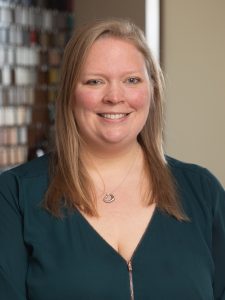Say the word whiteboard and a large white board, similar to a chalkboard, located at the front of a classroom is typically what comes to mind. While whiteboards are being placed at the front of a class, these non-permanent writing surfaces are also replacing the notebooks that students use as society grows more aware of environmental sustainability.
Unlike a traditional chalkboard permanently affixed to a classroom wall, options for non-permanent writing surfaces abound. Choices include whiteboard screens on wheels for easy movement, wall-mounted whiteboards and even personal-sized boards for individual use or small group collaboration. There are also whiteboard paint and vinyl surface options that allow for variations in size and shape, as well as boards made of glass and electronic boards that take advantage of the internet. There is sure to be a surface that fits with every pedagogy and budget.
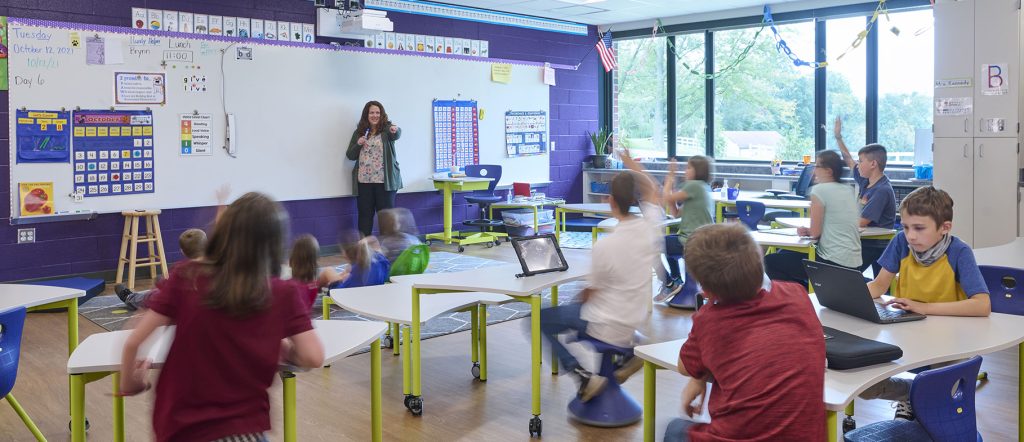
Non-permanent writing surfaces are more than just a place to write lessons. These surfaces promote a thinking classroom, and provide opportunities for mistake-driven learning. Among the many benefits of mistake-driven learning is that it develops risk taking and critical thinking skills in students. Non-permanent writing surfaces offer an ideal instrument for these abilities to flourish by offering a surface that students can make mistakes and then easily start over in their problem solving.
Along with having an easily erasable, re-writable surface, whiteboards can be magnetized which allows notes and visuals to be attached for easy reference. Often, these surfaces can also be used with a projector which facilitates another manner of classroom instruction. We discuss a few of the available options in this post.
Whiteboards: A familiar option for a non-permanent writing surface
Steel- or aluminum-based whiteboards offer a durable, and therefore cost-effective, option for educational environments. Typically, these types of whiteboards are made of a sheet of metal painted with a base coat and then treated with multiple layers of a clear coating. The clear coating enables the board to be written on and erased easily. While white is the most common color and gave the boards their familiar name, it is possible to make a “whiteboard” in different colors. If creating a custom board, once the base color is chosen, a logo or custom design can be incorporated for additional personalization.
Painted-steel whiteboard come in standard sizes. Custom sizes can be specially manufactured or users can align and install standard-sized boards next to each other. This makes this type of board very adaptable to unique room setups.
This type of surface also can be used with a projector. However, the quality of the projection often depends on the quality of the writing surface. High-gloss whiteboards tend to throw a lot of glare, impacting a viewer’s ability to see what is being projected.
Smaller, steel-based whiteboards are available for individual use as well as during small group collaboration during class. Often, these non-permanent writing surfaces can be attached to a desk and provide privacy during test taking or allow for individual study opportunities.
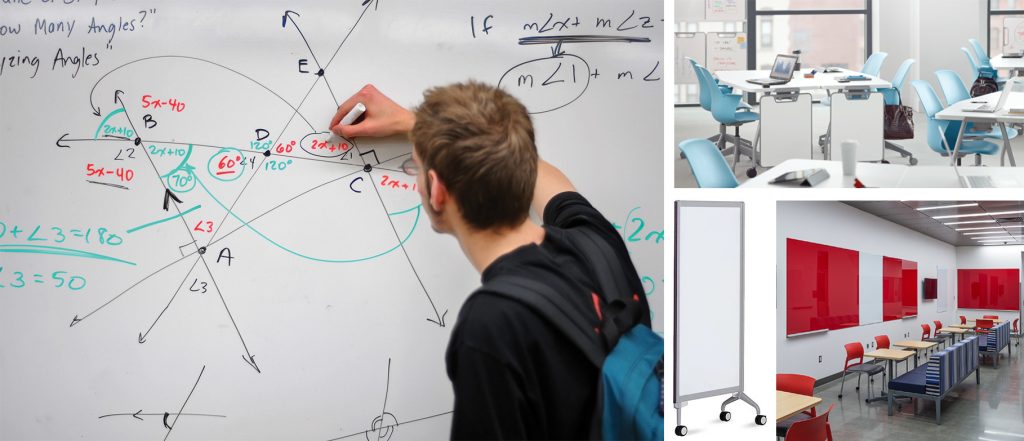
Larger boards are available mounted on wheels to enable idea sharing in groups. A single large whiteboard of this type can be wheeled to the front of a classroom when needed and stored out of the way when not in use. These boards can also be used, separately or in groups, to divide and define spaces in a room.
Whiteboard Paint: Creating a Writable Surface Anywhere
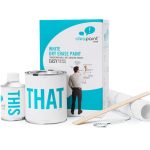 Whiteboard paint offers all the functionality of a regular whiteboard, and with correct preparation almost any vertical surface can be turned into an area that can be written on again and again. With the variety of different base colors and clear coat available, this type of non-permanent writing surface can be the exact size – and color – required. The stand-alone clear coating can be used to cover flat surfaces such as drywall, sealed wood, metal and other smooth wallcovering opening up even more options.
Whiteboard paint offers all the functionality of a regular whiteboard, and with correct preparation almost any vertical surface can be turned into an area that can be written on again and again. With the variety of different base colors and clear coat available, this type of non-permanent writing surface can be the exact size – and color – required. The stand-alone clear coating can be used to cover flat surfaces such as drywall, sealed wood, metal and other smooth wallcovering opening up even more options.
In addition to creating a writable surface, the paint can also be used to repair existing whiteboards in the classroom or other writing surfaces that have become damaged or unsightly.
Since this type of non-permanent writing surface is painted directly onto a wall, the surface suffers any damage the wall takes. When damage does occur, a new coat can be applied but the process involves prepping the entire surface again. Whiteboard paint also requires curing time before use. This ranges from a day or two upwards to a week before using, so installation and repairs are best done when classes are not in session.
On A Roll: Non-permanent Writable Vinyl Wall Coverings
Writable wall covering behaves much like wallpaper or other vinyl wall coverings. It is often available on rolls and installs like traditional wall coverings. If a larger writing surface is desired, rolls can be applied next to each other.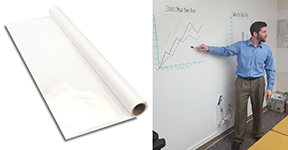
Writable vinyl wall covering can also be used to refurbish chalkboards or older whiteboards, but like paint, it requires surface preparation. The wallcoverings vary in both thickness and opacity, so a patterned or marred surface underneath may show through. Aside from an aesthetic impact, the “show through” is unlikely to impact the usability of the covering.
Non-permanent writable vinyl wall coverings are available with a variety of finishes including glossy, low-gloss, and matte options. This makes vinyl non-permanent writing surfaces ideal for projector use as well as for writing.
Glassboard: A modern take on non-permanent writing surfaces
In terms of appearance, glassboard ranks as one of the most contemporary non-permanent writing surfaces available. Glassboards are highly customizable. School colors, logos or custom designs can be applied to the substrate, covered in glass and turned into a writable surface. A steel substrate allows magnets to be used to hang notes, papers or keep markers close at hand.
Glassboards are extremely durable and are estimated to last decades longer than other types of non-permanent writing surfaces. The glass composition results in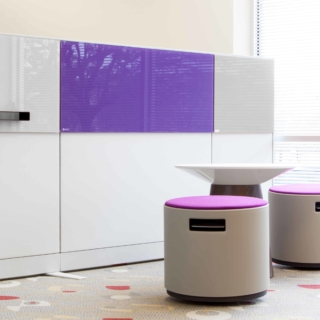 a nonporous surface that is impermeable to ink and germs. It also makes glassboards easy to clean, almost impossible to stain and highly sanitary. They easily withstand the day-to-day wear and tear of classroom use but often require a significant upfront investment. However, their projected lifespan and easy care help to offset initial cost.
a nonporous surface that is impermeable to ink and germs. It also makes glassboards easy to clean, almost impossible to stain and highly sanitary. They easily withstand the day-to-day wear and tear of classroom use but often require a significant upfront investment. However, their projected lifespan and easy care help to offset initial cost.
Unlike non-permanent writable surfaces created with whiteboard paint or vinyl covering, glassboard surfaces come in standard sizes. Placing single boards next to each other allows for a larger writing surface but results in a seamed edge.
Due to the refractive and reflective properties of glass, glassboards are not always the best choice for a projection surface. While there are manufacturers making boards that feature cinema-quality surfaces, projectors need to be hung in specific locations for optimal viewing.
The Future is Now: E-boards / SMARTboards / Interactive whiteboards
E-boards, SMARTboards or interactive whiteboards use the latest technology while keeping all the properties of a traditional non-permanent writing surface. These boards also boast simultaneous multi-user capability during instruction. These boards also have the capability to have class lessons and student work uploaded to the cloud for future reference.
All students connected to the display can interact with the board and share their work during class enhancing collaboration. Teachers maintain control the primary display via a tablet or smart device and can act as facilitator throughout the lesson. By taking advantage of the board’s internet capability, remote guest teachers, speakers or other professionals can easily join in the class to share ideas or make presentations.
Using shared writing surfaces in educational settings has shown to increase engagement and excitement; this is especially true among younger learners. For students in upper levels, writing boards facilitate peer-to-peer discussion and learning. No matter which non-permanent writing surface is utilized, these boards help promote more interactive, involved students. When students are actively engaged, they are set up for success. These students are much more likely to reach academic achievements, feel a sense of belonging and have better overall social-emotional well-being.
About the Author
During Jacqueline’s tenure at RLPS, she has been creating unique spaces for clients in the senior living and education markets. In designing for public and private schools, she focuses on creating functional, future-ready learning environments that improve SEL (social and emotional learning) of students as well as accommodate and enhance a variety of learning styles. When creating interiors for senior living, Jacqueline aims to provide living spaces that are home-like and inviting for residents. Her overall goal is to design interior areas that are safe, innovative, happy and welcoming to all. Jacqueline is an NCIDQ-registered interior designer, a member of...
Learn More About Jacqueline
